and the distribution of digital products.
State of Velo Q3 2024
- Velo recorded positive growth across key metrics in Q3 2024, including a ~59.68% increase in market cap, a ~10.92% MoM rise in USD-denominated TVL, a ~45.02% QoQ increase in average daily transactions on Nova, and a ~31.00% rise in average daily active addresses on Nova.
- However, VELO-denominated TVL declined ~7.30% MoM, while average daily active addresses on BSC fell ~8.59% QoQ, total fees dropped ~27.08% QoQ, and average daily transactions on BSC decreased ~59.35% QoQ.
- UOB Venture Management made its second strategic investment in Velo, reinforcing its confidence in the project.
- Velo expanded its ecosystem and real-world asset applications by launching the Omni Points decentralized application, integrating OpenEden’s tokenized U.S. Treasury Bills as collateral for USDV, and entering a Memorandum of Understanding (MOU) with U Power Limited to develop a blockchain-based platform for managing EV battery bank assets in South East Asia.
Velo (VELO) is an infrastructure platform bridging traditional finance with Web3 applications. Founded in 2018, its early efforts focused on developing the Digital Reserve System (DRS) and a digital credit issuance mechanism to enable secure and efficient cross-border settlements. By the end of 2023, Velo shifted its focus toward becoming a decentralized Web3 payment network (e.g., Velo Finance), while also introducing their Identity Framework as an additional feature. In late 2024, the project expanded its focus to include the tokenization of RWAs and introduced Orbit, a consumer super app that facilitates payments between Web2 and Web3.
Stellar, known for its low-cost and efficient transactions, is the foundation for Velo’s initial infrastructure. Nova, Velo’s EVM-compatible blockchain, allows smart contracts and supports DeFi operations, mainly on Universe, Velo’s hybrid exchange platform. BNB Smart Chain supports Velo Finance and facilitates wallet connections, serving as the primary on-and-off ramp for users within the ecosystem. The Warp bridge allows asset transfers between these various blockchains.
Additionally, the Omni Point loyalty program facilitates earning and redeeming points across Web2 and Web3 activities through Orbit. To meet regulatory requirements while preserving privacy, Velo’s Identity Framework combines KYC/KYB protocols with an anonymous blockchain layer, relying on licensed partners to manage KYC/KYB processes when needed.
Website / X (Twitter) / Discord
Key Metrics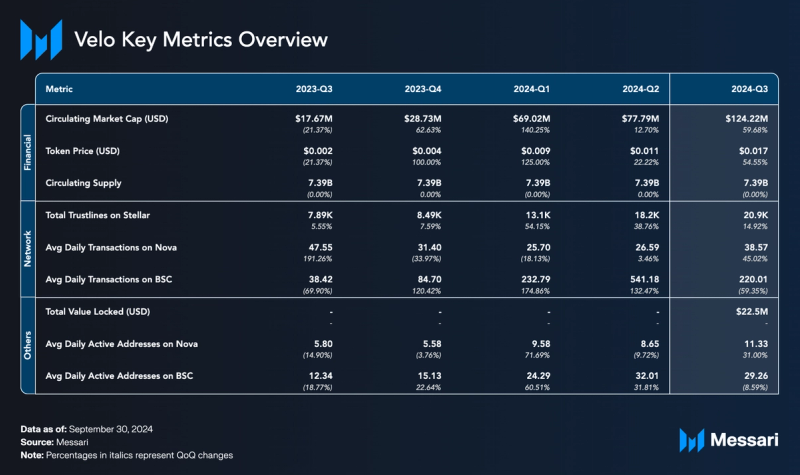 Financial Analysis
Financial Analysis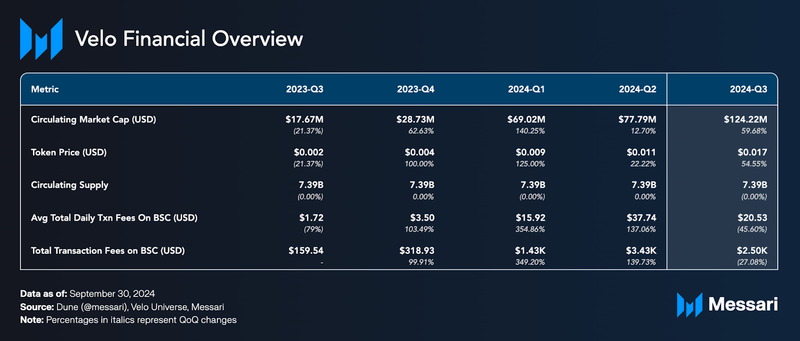 Market Cap and Price
Market Cap and Price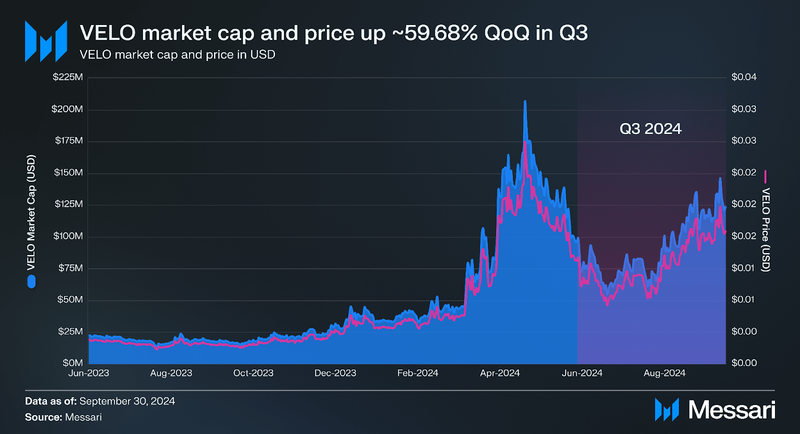
Velo demonstrated notable growth relative to BTC and ETH benchmarks, whose respective circulating market caps increased ~1.10% and decreased ~24.10% from Q2 to Q3. Velo’s circulating market cap rose ~59.68% from Q2 to Q3, reaching ~$124.22 million, increasing its market cap ranking from 439 at the end of Q2 to 328 by the end of Q3. The price of VELO mirrored its circulating market cap growth, climbing ~59.68% during the same period.
Since the beginning of 2024, VELO's market cap has increased ~79.97%, with its price reflecting a similar trajectory.
Fees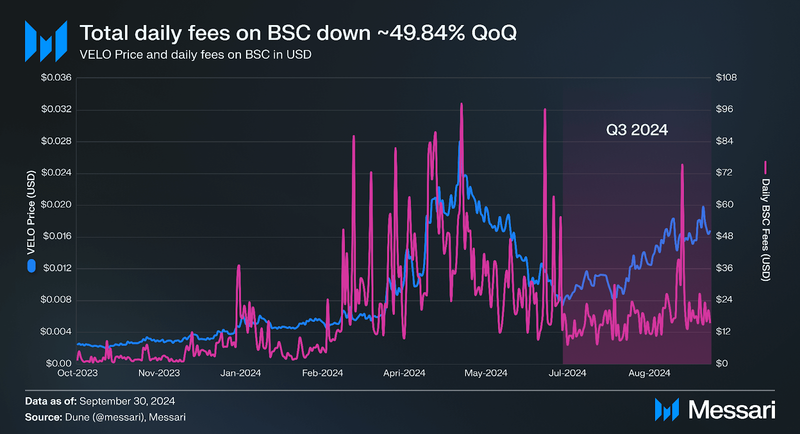
Fees are generated and summed across BSC. As background, despite Stellar being Velo's original blockchain, most operations have shifted to other blockchains. For example, Velo Finance, which focuses on Velo’s DeFi environment, operates on BNB Smart Chain (BSC). Universe, Velo’s hybrid exchange platform, uses both Nova and BSC, with users connecting via BSC but performing internal operations on Nova until funds are withdrawn. Quantum, Velo's remittance network, has not yet been implemented, but will use Stellar. Nova transaction fees were initially estimated using Universe trading fee data; however, this approach was excluded from QoQ calculations due to inconsistencies and potential skew. As outlined in Velo's documentation, the Nova blockchain uses NOVA as its gas fee, which holds no monetary value and, therefore, does not influence the overall QoQ fee trends. A more comprehensive overview can be read here.
Quarterly total fees had notable fluctuations throughout 2024, with cumulative activity peaking in Q2 before declining in Q3. Specifically, total fees across the quarter fell ~27.08% QoQ, dropping from ~$3,434.38 to ~$2,504.36. Despite this decline, cumulative fees remain up ~74.81% compared to Q1, where they totaled ~$1,432.63.
Average daily fees followed a similar trend, declining ~45.60% QoQ from ~$37.74 in Q2 to ~$20.53 in Q3. However, this still reflects a ~28.97% increase compared to the Q1 average of ~$15.92.
Despite the QoQ drop in total fees, VELO's native token price rose ~59.68% in Q3 and climbed ~252.76% since the start of the year. This divergence between network fees and price performance indicates a potential mismatch between underlying network activity and market sentiment. For context, in Q2, both total fees and VELO’s price moved in parallel, increasing ~139.73% and ~5.48%, respectively.
Network Analysis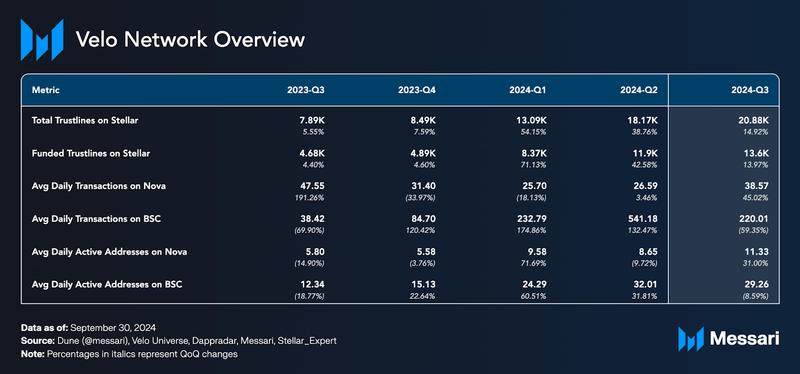 Usage
Usage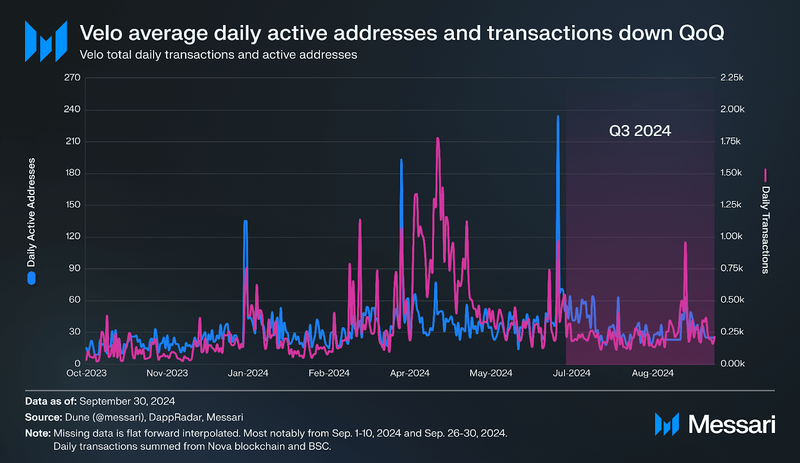
Transaction activity peaked on April 22, 2024, with ~1,818 transactions, while active addresses reached a maximum on July 1, 2024, at ~234. Just as average total daily fees slowed down in Q3, so did other parts of Velo's network activity. Specifically, average daily active addresses declined ~9.29% QoQ, dropping from ~40.66 in Q2 to ~36.88 in Q3. Despite this quarterly decline, active addresses still reflected a ~7.12% increase compared to Q1’s average of ~34.43. Average daily transactions followed this downtrend, decreasing ~55.64% QoQ from ~567.77 in Q2 to ~251.87 in Q3, representing a ~2.24% drop compared to Q1 levels of ~257.65. These trends highlight a notable slowdown in user engagement and transaction activity QoQ.
Breaking this down by blockchain, BSC, which powers Velo Finance, saw declines in Q3. Average daily active addresses on BSC dropped ~8.59% from ~32.01 to ~29.26, while average daily transactions fell ~59.35%, decreasing from ~541.18 to ~220.01. Nova, Velo's EVM-compatible blockchain, exhibited a different trend in Q3. Average daily active addresses on Nova increased ~31.00% from ~8.65 to ~11.33, while average daily transactions rose ~45.02%, increasing from ~26.59 to ~38.57, showing recovery after previous quarter declines.
Overall, BSC, the blockchain behind Velo Finance, was the primary driver of transaction activity in Q3, averaging ~220.01 daily transactions compared to Nova’s ~38.57. BSC also maintained higher user participation, with average daily active addresses at ~29.26, surpassing Nova’s ~11.33, despite a QoQ decline. These trends indicate that while BSC contributed to growth in network activity, Velo’s broader ecosystem still faces challenges in maintaining consistent user participation.
Trustlines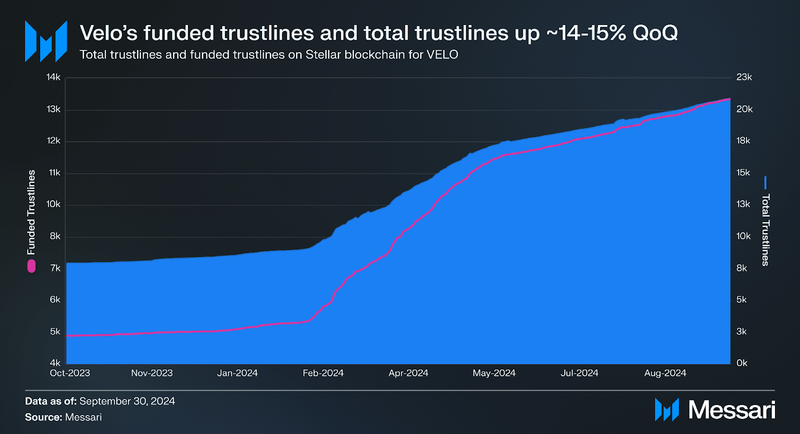
Trustlines on Stellar are agreements between an account and an asset issuer, allowing the account to hold and transact with a specific token. A funded trustline indicates active use by maintaining a non-zero balance. It's important to note that Velo's Quantum remittance network – the primary driver for trustline activity – has yet to be implemented.
Total trustlines have risen ~145.66% year to date, from ~8,498 to ~20,876. Similarly, funded trustlines have increased ~177.74%, from ~4,895 to ~13,601, over the same period.
In Q3 alone, total trustlines grew ~14.92% QoQ from ~18,166 to ~20,876, with a ~4.72% MoM increase in September. Funded trustlines mirrored this trend, rising ~13.97% QoQ from ~11,934 to ~13,601, with a ~4.50% MoM rise in September.
Additionally, the chart above depicts the gap between total and funded trustlines narrowing QoQ, indicating a higher conversion rate of established trustlines into active ones.
Ecosystem AnalysisTVL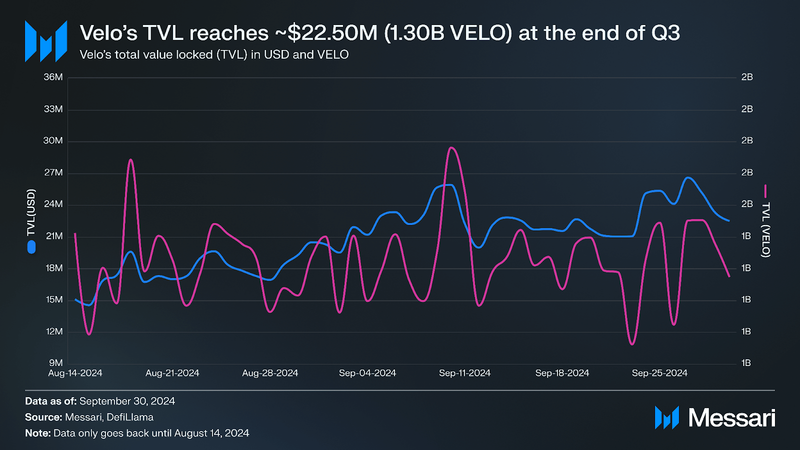
Velo Finance's TVL in USD terms rose ~10.92% MoM, increasing from ~$20.29 million to ~$22.50 million. In contrast, TVL measured in VELO terms declined ~7.30% over the same period, highlighting differing trends between token valuation and overall liquidity.
General Development and GrowthWhile the metrics above show mixed performance, Q3 saw several qualitative developments, with September as the most significant month for activity and growth. These events include:
July:
August:
- Bitget Wallet integrated Velo’s Universe Hybrid DEX.
- Velo is listed on the Uphold wallet.
- DefiLlama, an onchain data provider, began tracking VELO on BNB Smart Chain.
- Velo entered a Memorandum of Understanding (MOU) with U Power Limited to create a blockchain-based platform for managing EV battery bank assets in Southeast Asian countries.
September:
- Bitvavo, a European exchange, listed VELO.
- Velo collaborated with Securitize to integrate BlackRock's BUIDL fund.
- UOB Venture Management made its second investment in Velo for an undisclosed amount.
- Velo integrated OpenEden’s tokenized U.S. Treasury Bills as collateral for USDV.
- LY Technology PTE. LTD. launched the Omni Points decentralized app, powered by Velo's Orbit technology.
The broader crypto market displayed mixed performance in Q3, with BTC's circulating market cap rising ~1.10% while ETH declined ~24.10%. Velo’s performance also reflected a mix of trends. Specifically, its circulating market cap grew ~59.68% QoQ to ~$124.22 million, improving its rank from 439 to 328.
Transaction activity on Nova saw significant growth, with average daily transactions rising ~45.02% QoQ to ~38.57. However, this increase was offset by a ~59.35% decline in average daily transactions on BSC, dropping from ~541.18 to ~220.01. Meanwhile, average daily active addresses across both blockchains fell ~9.29% QoQ to ~36.88. With this, total transaction fees summed across the quarter declined ~27.08% QoQ to ~$2,504.36, down from ~$3,434.38 in Q2. Average daily transaction fees followed a similar trend, decreasing ~45.60% QoQ to ~$20.53 from ~$37.74.
Contrary to the above, USD-denominated TVL increased ~10.92% MoM to $22.50 million, while VELO-denominated TVL declined ~7.30%, falling from 1.15 billion VELO to 1.07 billion VELO. These trends overall indicate a divergence between token valuation, network activity, and user participation.
Despite this, development efforts remained active in Q3. Key milestones included (i) UOB Venture Management’s second investment in Velo, (ii) the launch of the Omni Points decentralized application powered by Orbit, (iii) the integration of OpenEden’s tokenized U.S. Treasury Bills as collateral for USDV, and (iv) a Memorandum of Understanding (MOU) with U Power Limited to develop a blockchain-based platform for managing EV battery bank assets in South East Asia. Together, these initiatives reflect Velo's broader focus on expanding its ecosystem and driving real-world blockchain adoption.
- Home
- About Us
- Write For Us / Submit Content
- Advertising And Affiliates
- Feeds And Syndication
- Contact Us
- Login
- Privacy
All Rights Reserved. Copyright , Central Coast Communications, Inc.